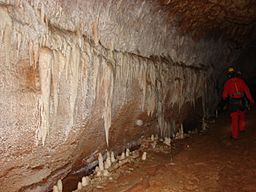Blanche Cave facts for kids
Quick facts for kids Blanche Cave |
|
|---|---|
 |
|
| Location | Naracoorte Caves National Park Joanna, South Australia |
| Length | 250 metres |
| Discovery | 1845 |
| Entrances | 3 |
Blanche Cave is one of 26 amazing caves found in the Naracoorte Caves National Park. This park is so special that it's a World Heritage listed area! Blanche Cave was the very first cave discovered by European settlers in the Naracoorte region back in 1845. Today, you can explore it yourself on a guided tour.
This cave has some cool features. It was once home to the naturally preserved remains of an Indigenous person. The cave has also hosted exciting events, like New Year's parties long ago. More recently, it was even part of the Olympic torch relay for the 2000 Summer Olympics in Sydney! Blanche Cave and the nearby Victoria Fossil Cave were added to the South Australian Heritage Register in 1984, recognizing their importance.
Contents
Exploring Blanche Cave
How the Cave Was Found
European settlers first discovered Blanche Cave around 1845. A local farm manager named Benjamin Sanders likely found it when he was looking for lost sheep. He probably followed the sheep right into the cave!
The first detailed description of the cave came 13 years later in 1858. A Reverend named Julian Woods wrote about his visit. He thought the cave entrance looked like a grand Gothic cathedral, with beautiful natural decorations. He described how stalagmites rising from the ground looked like kneeling figures.
Protecting the Cave
After it was discovered, people could enter the cave freely. Sadly, this led to some damage, especially near the entrance. Visitors would leave trash, and some even broke off the delicate cave formations.
In 1879, a journalist visited and noticed how much the cave had changed. He asked for someone to protect it. This led to the land around Blanche Cave being given to the South Australian Forest Board in 1885. A forester was hired to look after the cave, make it look better, and give tours.
One important forester was William Reddan. He worked hard to "beautify" the area, planting ferns and ornamental trees. In 1915, he even helped install colored electric lights inside the cave! That same year, the Tourist Bureau took over managing the caves. Reddan continued to work there until he retired in 1919.
Special Events in the Cave
Blanche Cave has always been a popular spot for special gatherings. As early as the 1860s, people held candlelit New Year's Eve parties inside! You can still see the remains of old benches near the entrance.
More recently, the cave played a part in the Olympic torch relay for the 2000 Summer Olympics in Sydney. The cave was lit by over 1000 candles as the Olympic Torch passed through. In 2003, the cave even hosted a play: Shakespeare's A Midsummer Night's Dream!
Blanche Cave, along with the nearby Victoria Fossil Cave, was officially added to the South Australian Heritage Register in 1984.
The Lost Exhibit
Not long after the cave was found, early explorers discovered the naturally preserved body of an Indigenous man inside. He was found on a rock ledge, looking as if he was asleep. It's believed he died there many years before the cave was discovered by Europeans.
The body was unique because it was "dried and shriveled" and partly covered in limestone from an active flowstone. This natural process, where minerals from water build up, made parts of his body almost "petrified." This process would have taken a very long time, suggesting he died long before 1845.
In 1858, Julian Woods wrote about the body in his cave description. The site where the body was found became known as the "Lost Exhibit" after it was removed from the cave.
What's Inside Blanche Cave?
Blanche Cave has three main sections.
- The entrance chamber is at the south-eastern end. Here, you can still see the old wooden tables and benches from past events.
- The middle chamber has two "windows" – these are holes in the roof that let sunlight stream in. These holes also serve as two of the three possible entrances to the cave. You'll also see some dry columns here.
- The third chamber is the largest. This is where the "Lost Exhibit" site is located. This chamber also contains the remains of a bat guano quarry, which was called the "Devil's Pit." There's also a structure known as the "Post Office."
The damage caused by early visitors has been partly fixed over time. Nature itself has helped heal some of the scars. However, planting pine trees nearby actually stopped water from dripping through the cave, which slowed down its natural restoration. When these pine trees were removed in the late 1980s, the cave began to rejuvenate and heal even more.

